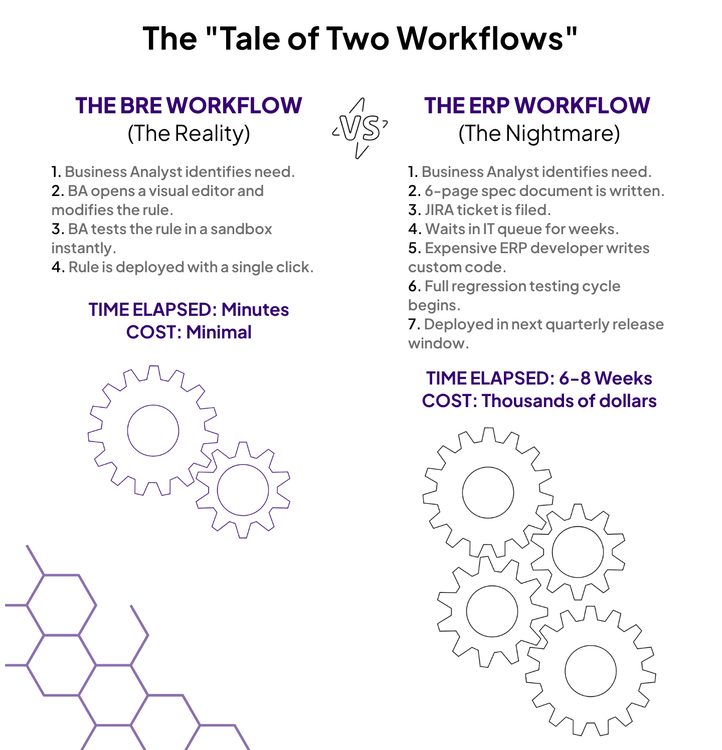Your ERP is the indispensable core of your enterprise, the System of Record that provides a solid foundation and a single source of truth for your most critical data. By design, these systems excel at stability, not rapid change. Their core logic is built to be universal, which means adapting it to your company's unique and evolving business rules often becomes a complex, time-consuming, and expensive project. The standard "configuration" options, while useful, are rarely enough to handle the dynamic, conditional logic that modern business demands.
A Common Challenge: The Complex Pricing Rule
Consider a common business need:
"If a premium customer's quarterly spend exceeds $10k, apply a 15% discount on electronics in their next order over $5k."
The business logic is clear, however, implementing it within a standard ERP is anything but simple. Such a request initiates a significant internal project, requiring specialized developers, lengthy test cycles and considerable cost. And all of the above delays the business’s ability to respond to market opportunities.
The Architectural Solution: Decoupling Your System of Decision
The architectural best practice is not to force the ERP to be something it's not. The solution is to decouple your business logic. By externalizing the dynamic, frequently-changing rules to a dedicated Business Rule Engine (BRE), you allow each system to perform its optimal function. This approach empowers business users, the domain experts, to manage their own logic in a user-friendly environment, without needing to touch the core ERP code.
This architectural pattern establishes a clear separation of concerns, solidifying the ERP as the stable "System of Record" responsible for the "what"—your core data integrity. The BRE is introduced as the agile "System of Decision" responsible for the "if-then"—your dynamic business logic. This enhances your ERP with an intelligent layer that can adapt at the speed of your business, without compromising the stability of your core systems.
The Benefits of a Decoupled Architecture
Unmatched Agility: Business users can update complex rules in the BRE in minutes—reacting to market changes without filing a single IT ticket. The business is no longer constrained by development cycles.
Drastically Reduced Costs: You eliminate the need for expensive, specialized ERP developers to code routine business logic. This frees them to work on high-value core system projects, maximizing the ROI on your most valuable technical talent.
Guaranteed Consistency: By centralizing logic in a BRE, you ensure every decision is made using the same rules, applied uniformly across the entire enterprise, even in applications outside the core ERP.
Effortless Auditability: A BRE provides a clear, transparent, and user-friendly audit trail for every single decision. This simplifies compliance, reduces risk, and provides invaluable data for business analysis.
Future-Proof Scalability: Your business logic can grow in complexity without degrading the performance of your core ERP. Each system scales independently, creating a more resilient and future-proof architecture.


Jan Binko
Product Owner
